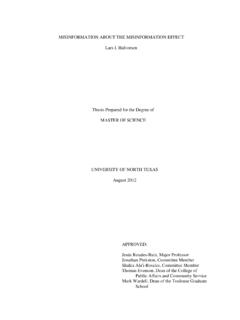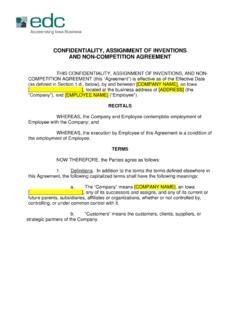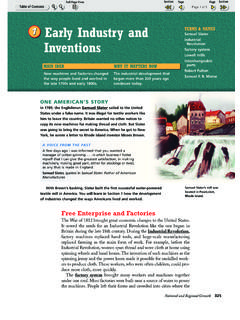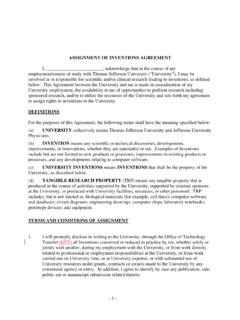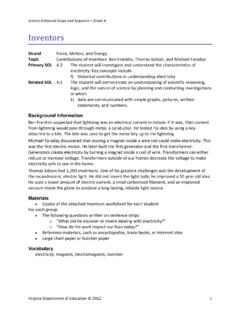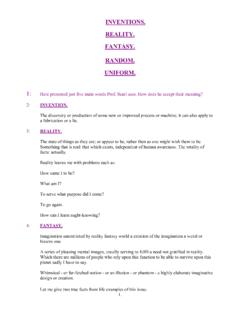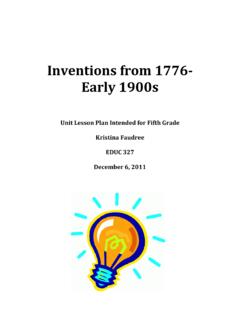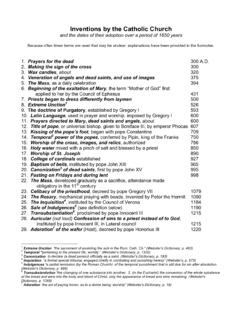Transcription of A PEDAGOGICAL APPROACH TO THE BACH TWO PART …
1 1A PEDAGOGICAL APPROACH TO THE BACHTWO part INVENTIONSTHESISP resented to the Graduate Council of theNorth Texas State University in PartialFulfillment of the RequirementsFor the Degree ofMASTER OF MUSICByCarol W. Coryell, B. M. , TexasJanuary, 1969 PREFACES ince the nineteenth century the Two part Inventionshave become standard repertoire for piano students. However,piano teachers have often failed to give serious considerationto the suitable selection of Inventions for study. Pianostudents have commonly formed a dislike for Bach's pianomusic because of an ungratifying initial is little material written in English dealing withthe Two part Inventions. Those studies of the Inventionswhich do exist consist mainly of brief articles in periodicalsand limited discussions in piano literature books. Therefore,there seemed to be a need for a systematic collection ofpedagogical ideas concerning the Two part Inventions.
2 Inaddition, it was felt that an analysis of the problems ineach piece and a subsequent graded list of the Inventionswould be a step toward a more intelligent and more knowledge-able APPROACH in the teaching of these OF CONTENTSPageLIST OF TABLES ..viiLIST OF ILLUSTRATIONS ..xChapterI. STATEMENT OF THE PROBLEM ..1 The PurposeSub-ProblemsDefinition of TermsDelimitationsBasic HypothesisBasic AssumptionsBackground for the Study J. S. Bach:Two part Inventions Related ResearchMethodologyPlan of This ReportII. A STYLISTIC ANALYSIS OF THE BACHTWO part INVENTIONS ..28 IntroductionInvention No. IInvention No. IIInvention No. IIII nvention No. IVInvention No. VInvention No. VIInvention No. VIII nvention No. VIIII nvention No. IXInvention No. XInvention No. XIInvention No. XIII nvention No. XIIII nvention No. XIVI nvention No. XVSummaryivTABLE OF CONTENTS--ContinuedPageChapterIII. IDENTIFICATION OF PERFORMANCE PROBLEMS ANDRANKING OF THE TWO part .
3 142 Performance Problems Related toLinear CharacteristicsPerformance Problems Related toTextural CharacteristicsPerformance Problems Related toRhythmic CharacteristicsPerformance Problems Related toFormal DesignRanking of the Two part InventionsRequirements for Performance of BachWhen to Begin the Study of theInventionsEditionsSummaryIV. SUMMARY, CONCLUSIONS, AND RECOMMENDATIONS..171 Summary and *..179 Appendix A:Appendix B:Appendix C:Appendix D:Appendix E:Appendix F:Appendix G:Frequencies of Parallel, Similar,Oblique, and Contrary Motion, andMelodic Indices in the Two PartInventionsFrequencies of Relatively AccentedDissonant Intervals in the TwoPart InventionsPer Cent of Rough and Smooth MeasuresAccording to Melodic AccentsPer Cent of Rough and-Smooth MeasuresAccording to Durational AccentsPiano PedagoguesRating SheetTempos for the Two part InventionsSuggested by Five AuthoritiesVTABLE OF.
4 ViLIST OF TABLESPage36434551I. Frequency of Counterpoint Species inInvention No. I ..II. Frequency of Note Values in InventionNo. I ..0 .d ..0. 4..III. Frequency of Counterpoint Species inInvention No..IV. Frequency of Note Values in InventionNo. II .*.*.*. *. *. Frequency of Counterpoint Species inInvention No. III ..VI. Frequency of Note Values inInvention No. III ..VII. Frequency of Counterpoint Species inInvention No..% ..VIII. Frequency of Note Values in InventionNo. IV ..IX. Frequency of Counterpoint Species inInvention No. V ..X. Frequency of Note Values in InventionNo. V ..*..XI. Frequency of Counterpoint Species inInvention No. VI ..XII. Frequency of Note Values in InventionNo..XIII. Frequency of Counterpoint Species inInvention No. VII ..0 ..0 ..0 ..LIST OF TABLES--ContinuedPageTableXIV. Frequency of Note Values in InventionNo. VII ..XV. Frequency of Counterpoint Species inInvention No.
5 VIII ..XVI. Frequency of Note Values in InventionNo. VIII ..XVII. Frequency of Counterpoint Species inInvention No. IX ..XVIII. Frequency of Note Values in InventionNo. IX ..XIX. Frequency of Counterpoint Species inInvention No. X ..XX. Frequency of Note Values in InventionNo. X ..XXI. Frequency of Counterpoint Species inInvention No. XI ..XXII. Frequency of Note Values in InventionNo. XI ..XXIII. Frequency of Counterpoint Species inInvention No. XII ..XXIV. Frequency of Note Values in InventionNo. XII ..XXV. Frequency of Counterpoint Species inInvention No. XIII ..XXVI. Frequency of Note Values in InventionNo. XIII..XXVII. Frequency of Counterpoint Species inInvention No. XIV ..0..* .. *. OF TABLES--ContinuedTable PageXXVIII. Frequency of Note Values in InventionNo. XIV ..126 XXIX. Frequency of Counterpoint Species inInvention No. XV ..132 XXX. Frequency of Note Values in InventionNo.
6 133 XXXI. Numerical values of the Factors Relating toDifficulty in the Two part Inventions..153 XXXII. Ranking of the Two part Inventions inOrder of Decreasing DifficultyAccording to Composite ScoresRelating to Difficulty ..155 XXXIII. Levels of Difficulty of Performance ofthe Inventions as Rated by SixCollege Piano Instructors .. 157 XXXIV. Ranking of the Two part Inventions Accordingto Technique, Memorization, Interpretationand Composite Scores in order ofDecreasing Difficulty .. 160 XXXV. A Comparison of the Ranking of the Two PartInventions Based on the Evaluations ofSix Pedagogues and the Ranking Basedon the Factors Relating to Difficulty 161ixLIST OF ILLUSTRATIONSF igure Page1. invention No. VII, Melodic Pattern, Measure 21 132. invention No. I, Melodic Pattern, Measure 21 ..143. invention No. XI, Melodic Pattern, Measure 4 ..144. invention No. I, Motive, Measure 1 ..315.
7 Legend Explaining Symbols Used in Graphic Analysis 326. invention No. I, Countermotive, Measures 1-2 ..337. invention No. I, Graphic Analysis ..348. invention No. I, Episodic Pattern, Measure 3 ..359. invention No. I, Episodic Pattern, Measures 9-10 .3510. invention No. II, Graphic Analysis ..4011. invention No. II, Motive, Measures 1-3 ..4112. invention No. II, Countermotive, Measures 3-5..4213. invention No. II, Episodic Pattern, Measures 5-10. 4214. invention No. II, Formal Plan ..4615. invention No. III, Motive A, Measures 1-2 ..4616. invention No. III, Graphic Analysis..4717. invention No. III, Motive B, Measures 12-14..4918. invention No. III, Episodic Pattern, Measures 5-11 5019. invention No. IV, Motive, Measures 1-3 ..5420. invention No. IV, Graphic Analysis ..55xLIST OF ILLUSTRATIONS--ContinuedFigure21. invention invention invention invention invention invention invention invention invention invention invention invention invention invention invention invention invention invention invention invention , Countermotive, Measures , Episodic Pattern, Measure , Episodic Pattern, Measure 11IV, Episodic Pattern, Measures 7-8V, Graphic Analysis.
8 V, Motive Measures 1-5 ..V, Countermotive, Measures 1-5VI, Motive A, Measures 1-4 ..VI, Motive B, Measures 1-5 ..VI, Graphic Analysis ..VII, Graphic Analysis ..VII, Motive, Measure 1 ..VIII, Motive, Measures 1-2 ..VIII, Graphic Analysis ..VIII, Countermotive, Measures , Episodic Pattern, Measure , Episodic Pattern, Measure 15IX, Motive A, Measures 1-4 ..IX, Motive B, Measures 1-4 ..IX, Graphic Analysis .. OF and 7 invention No. XIV, Graphic AnalysisInvention No. XIV, Countermotive, Measures 1-3IX, Rhythmic Pattern, Measures 1-2 .X, Motive, Measures 1-2 ..0 .X, Countermotive, Measures 2-3 ..X, Graphic Analysis ..X, Episodic Patterns, .0 .0 ..* .XI, Graphic Analysis ..XI, Motive A, Measures 1-3 ..XI, Motive B, Measures , Motive A, Measures 1-2..XII, Graphic Analysis .*.0 .t .XII, Motive B, Measures 1-2..XII, Episodic Pattern, Measure 7.
9 XIII, Motive A, Measure 1..XIII, Graphic , Countermotive A, Measure 1 .XIII, Motive B, Measure , Countermotive B, Measure 3 ..XIV, Motive, Measures OF ILLUSTRATIONS--ContinuedFigure Page61. invention No. XIV, Stretto, Measures 16-17 .. 12762. invention No. XV, Motive, Measures 1-3 ..12863. invention No. XV, Graphic .. 12964. invention No. XV, Countermotive, Measures 3-4 .13065. invention No. XV, Episodic Pattern, Measure 8..13066. invention No. XV, Episodic Pattern, * ..*..131xiiiCHAPTER ISTATEMENT OF THE PROBLEMThe PurposeThe purpose of this study was to analyze the Bach TwoPart Inventions and to prepare a graded list for of the problem statement led to subordinatequestions, which may be stated as follows:1. What performance problems are identifiable through ananalysis of the linear characteristics in the Two PartInventions?2. What performance problems are identifiable throughan analysis of the textural characteristics of these pieces?
10 3. What performance problems are identifiable throughan analysis of the rhythmic characteristics in the Inventions?4. What performance problems are identifiable throughan analysis of the formal design of these pieces?5. What system can be devised to grade the Inventionsin order of difficulty?12 Definition of Terms1. The term "performance problems" refers to difficul-ties encountered in the playing of a composition by an inter-mediate student on the piano. These problems may be dividedinto two basic categories: technical difficulties andinterpretative The term "technical difficulties" refers to thedemands placed upon the mechanical skill of the per-former. They include coordination, voice projection,balance, touch, tempo, and execution of ) The word "coordination" refers to the harmoni-ous functioning of muscles in producing complex,and sometimes, dissimilar, movements (15, p.



